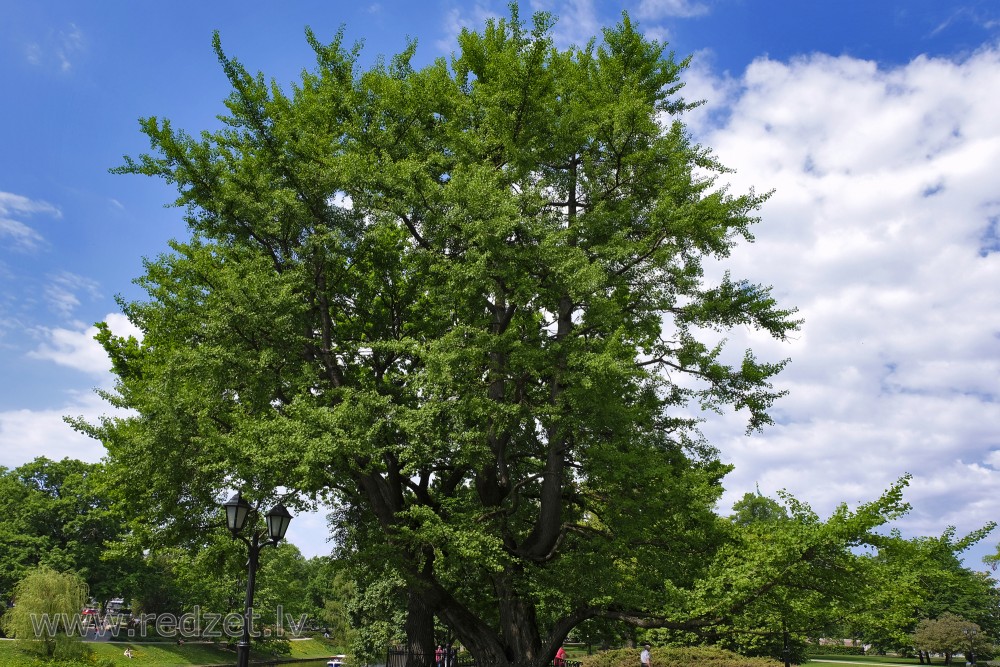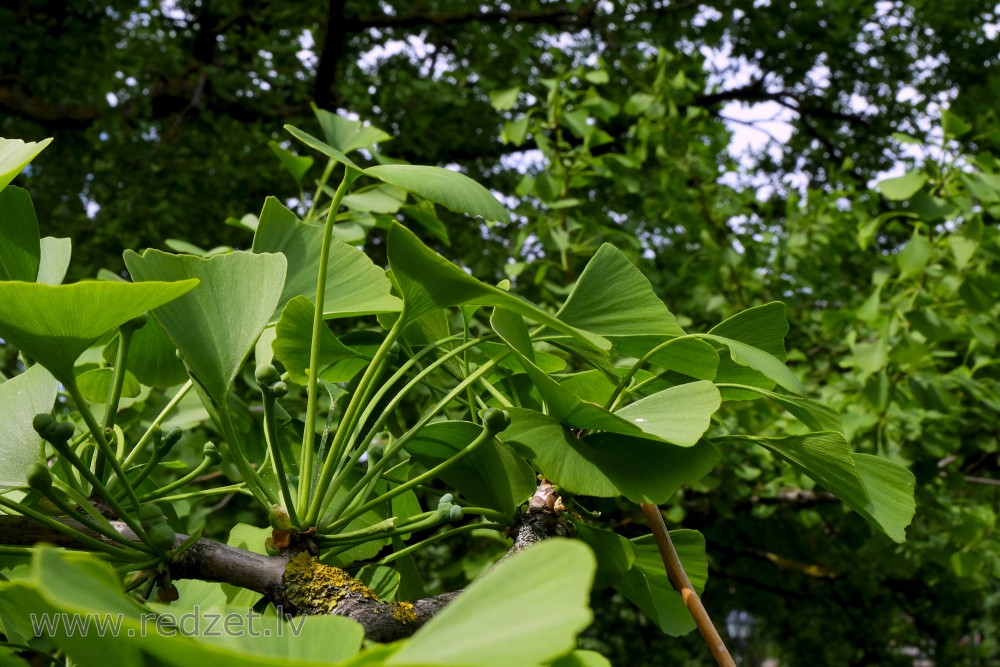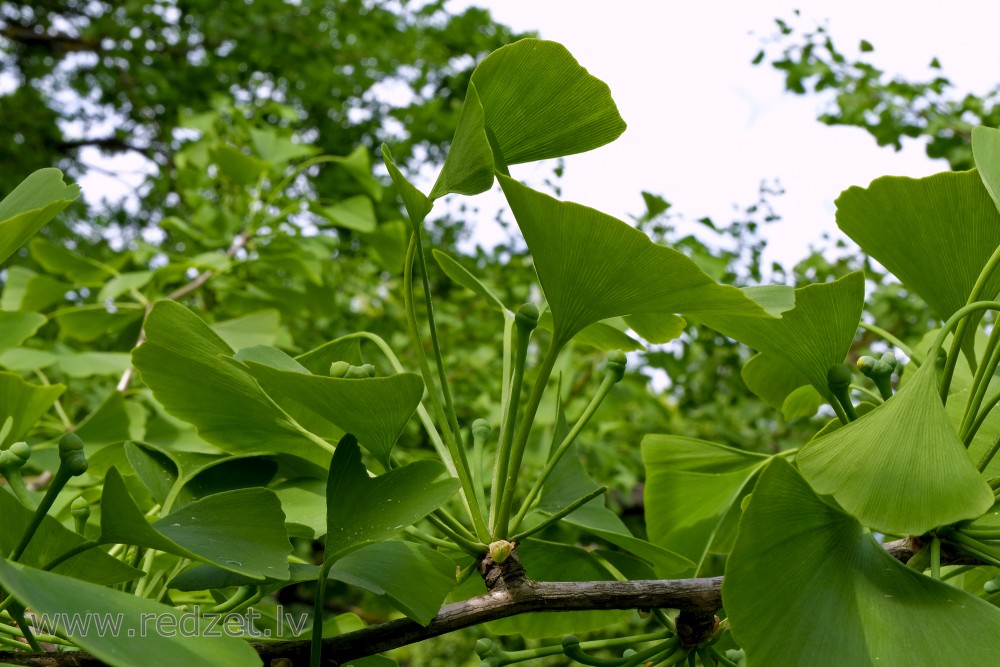(Ginkgo biloba) Ginkgo
Ginkgo biloba, commonly known as ginkgo or gingko (both pronounced /ˈɡɪŋkoʊ/), also known as the maidenhair tree, is the only living species in the division Ginkgophyta, all others being extinct. It is found in fossils dating back 270 million years. Native to China, the tree is widely cultivated, and was cultivated early in human history. It has various uses in traditional medicine and as a source of food.
Etymology
The genus name Ginkgo is regarded as a misspelling of the Japanese gin kyo, "silver apricot",which is derived from the Chinese 銀杏 used in Chinese herbalism literature such as Shaoxing Bencao (紹興本草) and Compendium of Materia Medica.
Engelbert Kaempfer first introduced the spelling ginkgo in his book Amoenitatum Exoticarum.[7] It is considered that he may have misspelled "Ginkjo" as "Ginkgo". This misspelling was included by Carl Linnaeus in his book Mantissa plantarum II and has become the name of the tree's genus.
Since the spelling may be confusing to pronounce, ginkgo is sometimes purposely misspelled as "gingko".
Description
Ginkgos are large trees, normally reaching a height of 20–35 m (66–115 ft), with some specimens in China being over 50 m (160 ft). The tree has an angular crown and long, somewhat erratic branches, and is usually deep rooted and resistant to wind and snow damage. Young trees are often tall and slender, and sparsely branched; the crown becomes broader as the tree ages. During autumn, the leaves turn a bright yellow, then fall, sometimes within a short space of time (one to 15 days). A combination of resistance to disease, insect-resistant wood and the ability to form aerial roots and sprouts makes ginkgos long-lived, with some specimens claimed to be more than 2,500 years old.
Ginkgo is a relatively shade-intolerant species that (at least in cultivation) grows best in environments that are well-watered and well-drained. The species shows a preference for disturbed sites; in the "semiwild" stands at Tian Mu Shan, many specimens are found along stream banks, rocky slopes, and cliff edges. Accordingly, ginkgo retains a prodigious capacity for vegetative growth. It is capable of sprouting from embedded buds near the base of the trunk (lignotubers, or basal chichi) in response to disturbances, such as soil erosion. Old individuals are also capable of producing aerial roots on the undersides of large branches in response to disturbances such as crown damage; these roots can lead to successful clonal reproduction upon contacting the soil. These strategies are evidently important in the persistence of ginkgo; in a survey of the "semiwild" stands remaining in Tianmushan, 40% of the specimens surveyed were multistemmed, and few saplings were present.
Uses
Horticulture
Ginkgos are popular subjects for growing as penjing and bonsai; they can be kept artificially small and tended over centuries. Furthermore, the trees are easy to propagate from seed.
Cooking
The nut-like gametophytes inside the seeds are particularly esteemed in Asia, and are a traditional Chinese food. Ginkgo nuts are used in congee, and are often served at special occasions such as weddings and the Chinese New Year (as part of the vegetarian dish called Buddha's delight). In Chinese culture, they are believed to have health benefits; some also consider them to have aphrodisiac qualities. Japanese cooks add ginkgo seeds (called ginnan) to dishes such as chawanmushi, and cooked seeds are often eaten along with other dishes.
When eaten in large quantities or over a long period, the gametophyte (meat) of the seed can cause poisoning by 4'-O-methylpyridoxine (MPN). MPN is heat-stable and not destroyed by cooking.Studies have demonstrated the convulsions caused by MPN can be prevented or treated successfully with pyridoxine (vitamin B6).
Some people are sensitive to the chemicals in the sarcotesta, the outer fleshy coating. These people should handle the seeds with care when preparing the seeds for consumption, wearing disposable gloves. The symptoms are allergic contact dermatitis or blisters similar to that caused by contact with poison ivy.
Traditional medicine
The first use as a medicine is recorded in the late 15th century in China; among western countries, its first registered medicinal use was in Germany in 1965. Despite use, controlled studies do not support the extract's efficacy for most of the indicated conditions.
Dietary supplement
Although extracts of Ginkgo biloba leaf sold as dietary supplements may be marketed as being beneficial for cognitive function, there is no evidence for effects on memory or attention in healthy people. Gingko extract has also been studied in Alzheimer's disease, but there is no good evidence that it has any effect.
Systematic reviews have shown there is no evidence for effectiveness of ginkgo in treating high blood pressure, menopause-related cognitive decline, tinnitus, post-stroke recovery, peripheral arterial disease, macular degeneration, or altitude sickness.
Adverse effects
The use of Ginkgo biloba leaf extracts may have undesirable effects, especially for individuals with blood circulation disorders and those taking anticoagulants, such as aspirin or warfarin, although studies have found ginkgo has little or no effect on the anticoagulant properties or pharmacodynamics of warfarin in healthy subjects. Additional side effects include increased risk of bleeding, gastrointestinal discomfort, nausea, vomiting, diarrhea, headaches, dizziness, heart palpitations, and restlessness.
According to a systemic review, the effects of ginkgo on pregnant women may include increased bleeding time, and it should be avoided during lactation because of inadequate safety evidence.
Ginkgo biloba leaves and sarcotesta also contain ginkgolic acids,which are highly allergenic, long-chain alkylphenols such as bilobol or adipostatin A (bilobol is a substance related to anacardic acid from cashew nut shells and urushiols present in poison ivy and other Toxicodendron spp.)Individuals with a history of strong allergic reactions to poison ivy, mangoes, cashews and other alkylphenol-producing plants are more likely to experience allergic reaction when consuming non-standardized ginkgo-containing preparations, combinations, or extracts thereof. The level of these allergens in standardized pharmaceutical preparations from Ginkgo biloba was restricted to 5 ppm by the Commission E of the former Federal German Health Authority. Overconsumption of seeds from Gingko biloba can deplete vitamin B6.
History
The ginkgo is a living fossil, with fossils recognisably related to modern ginkgo from the Permian, dating back 270 million years. The most plausible ancestral group for the order Ginkgoales is the Pteridospermatophyta, also known as the "seed ferns"; specifically the order Peltaspermales. The closest living relatives of the clade are the cycads,which share with the extant G. biloba the characteristic of motile sperm.
Fossil plants with leaves that have more than four veins per segment have customarily been assigned to the taxon Ginkgo, while the taxon Baiera is used to classify those with fewer than four veins per segment. Sphenobaiera has been used for plants with a broadly wedge-shaped leaf that lacks a distinct leaf stem.
Rise and decline
Fossils attributable to the genus Ginkgo first appeared in the Early Jurassic. One of the earliest fossils ascribed to the Ginkgophyta is Trichopitys, distinguished by having multiple-forked leaves with cylindrical (not flattened), thread-like ultimate divisions.The genus Ginkgo diversified and spread throughout Laurasia during the middle Jurassic and Early Cretaceous.
The Ginkgophyta declined in diversity as the Cretaceous progressed, and by the Paleocene, Ginkgo adiantoides was the only Ginkgo species left in the Northern Hemisphere, while a markedly different (and poorly documented) form persisted in the Southern Hemisphere. Along with that of ferns, cycads, and cycadeoids, the species diversity in the genus Ginkgo drops through the Cretaceous, at the same time the flowering plants were on the rise; this supports the hypothesis that, over time, flowering plants with better adaptations to disturbance displaced Ginkgo and its associates.
At the end of the Pliocene, Ginkgo fossils disappeared from the fossil record everywhere except in a small area of central China, where the modern species survived.
Limited number of species
It is doubtful whether the Northern Hemisphere fossil species of Ginkgo can be reliably distinguished. Given the slow pace of evolution and morphological similarity between members of the genus, there may have been only one or two species existing in the Northern Hemisphere through the entirety of the Cenozoic: present-day G. biloba (including G. adiantoides) and G. gardneri from the Paleocene of Scotland.
At least morphologically, G. gardneri and the Southern Hemisphere species are the only known post-Jurassic taxa that can be unequivocally recognised. The remainder may have been ecotypes or subspecies. The implications would be that G. biloba had occurred over an extremely wide range, had remarkable genetic flexibility and, though evolving genetically, never showed much speciation.
While it may seem improbable that a single species may exist as a contiguous entity for many millions of years, many of the ginkgo's life-history parameters fit: Extreme longevity; slow reproduction rate; (in Cenozoic and later times) a wide, apparently contiguous, but steadily contracting distribution; and (as far as can be demonstrated from the fossil record) extreme ecological conservatism (restriction to disturbed streamside environments).
Adaptation to a single environment
Given the slow rate of evolution of the genus, Ginkgo possibly represents a pre-angiosperm strategy for survival in disturbed streamside environments. Ginkgo evolved in an era before flowering plants, when ferns, cycads, and cycadeoids dominated disturbed streamside environments, forming low, open, shrubby canopies. Ginkgo's large seeds and habit of "bolting" – growing to a height of 10 meters before elongating its side branches – may be adaptions to such an environment.
Modern-day G. biloba grows best in environments that are well-watered and drained, and the extremely similar fossil Ginkgo favored similar environments: The sediment record at the majority of fossil Ginkgo localities indicates it grew primarily in disturbed environments, along streams and levees. Ginkgo, therefore, presents an "ecological paradox" because while it possesses some favorable traits for living in disturbed environments (clonal reproduction) many of its other life-history traits are the opposite of those exhibited by modern plants that thrive in disturbed settings (slow growth, large seed size, late reproductive maturity).
Naming
The older Chinese name for this plant is 銀果, meaning "silver fruit", pronounced yínguǒ in Mandarin or Ngan-gwo in Cantonese. The most usual names today are 白果 (bái guǒ), meaning "white fruit", and 銀杏 (yínxìng), meaning "silver apricot". The name 銀杏 was borrowed in Japanese ぎんなん (ginnan) and Korean 은행 (eunhaeng), when the tree was introduced from China.
Cultivation
Ginkgo has long been cultivated in China; some planted trees at temples are believed to be over 1,500 years old. The first record of Europeans encountering it is in 1690 in Japanese temple gardens, where the tree was seen by the German botanist Engelbert Kaempfer. Because of its status in Buddhism and Confucianism, the ginkgo is also widely planted in Korea and parts of Japan; in both areas, some naturalization has occurred, with ginkgos seeding into natural forests.
In some areas, most intentionally planted ginkgos are male cultivars grafted onto plants propagated from seed, because the male trees will not produce the malodorous seeds. The popular cultivar ‘Autumn Gold’ is a clone of a male plant.
The disadvantage of male Ginkgo biloba trees is that they are highly allergenic. They have an OPALS allergy scale rating of 7 (out of 10), whereas female trees, which can produce no pollen, have an OPALS allergy scale rating of 2.
Female cultivars include ‘Liberty Splendor’, ‘Santa Cruz’, and ‘Golden Girl’, the latter so named because of the striking yellow color of its leaves in the fall; all female cultivars release zero pollen.
Many cultivars are listed in the literature in the UK, of which the compact ‘Troll’ has gained the Royal Horticultural Society’s Award of Garden Merit.
Ginkgos adapt well to the urban environment, tolerating pollution and confined soil spaces.They rarely suffer disease problems, even in urban conditions, and are attacked by few insects.
Society and culture
The ginkgo leaf is the symbol of the Urasenke school of Japanese tea ceremony. The tree is the official tree of the Japanese capital of Tokyo, and the symbol of Tokyo is a ginkgo leaf. The logo of Osaka University has been a simplified ginkgo leaf since 1991 when designer Ikko Tanaka created it for the university's sixtieth anniversary.
Hiroshima
Extreme examples of the ginkgo's tenacity may be seen in Hiroshima, Japan, where six trees growing between 1–2 kilometres (0.62–1.24 mi) from the 1945 atom bomb explosion were among the few living things in the area to survive the blast. Although almost all other plants (and animals) in the area were killed, the ginkgos, though charred, survived and were soon healthy again, among other hibakujumoku (trees that survived the blast).
The six trees are still alive: They are marked with signs at Housenbou (報専坊) temple (planted in 1850), Shukkei-en (planted about 1740), Jōsei-ji (planted 1900), at the former site of Senda Elementary School near Miyukibashi, at the Myōjōin temple, and an Edo period-cutting at Anraku-ji temple.
1000-year-old ginkgo at Tsurugaoka Hachimangū
The ginkgo tree that had stood next to Tsurugaoka Hachiman-gū's stone stairway approximately from the Shinto shrine's foundation in 1063, and which appears in almost every old depiction of the shrine, was completely uprooted and irreparably damaged on March 10, 2010.[70] According to an expert who analyzed the tree, the fall was likely due to rot.
Later, both the stump of the severed tree and a replanted section of the trunk sprouted leaves. The shrine is in the city of Kamakura, Kanagawa Prefecture, Japan.
The tree was nicknamed kakure-ichō (hiding ginkgo), deriving from an Edo period urban legend which told of the assassination of Minamoto no Sanetomo by his nephew, Kugyō, who had been hiding behind the tree.
en.wikipedia.org
https://en.wikipedia.org/wiki/Ginkgo_biloba
Continue reading

